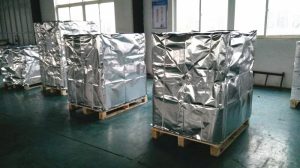Safe Storage Of Powder Coating

Proper storage for powder coating prevents particle agglomeration and reaction advancement, and ensures satisfactory application,this is pivotal. During application powder coatings must be easily fluidizable, free-flowing, and capable of accepting and maintaining a good electrostatic charges.
Factors affecting powder coatings storage
The key factors affecting powder coatings storage can be identified as:
- Temperature
- Moisture / Humidity
- Contamination
- Direct sunlight
The recommended optimum conditions for storage of powder coating are:
- Temperature < 25°C
- Relative humidity 50 – 65%
- Away from direct sunlight
Effect of temperature and humidit
When the powder is exposed for an extended period of time to higher temperature or higher relative humidity than recommended, the powder particles could agglomerate and form lumps.Quite often, the lumps are soft and crushable and are readily broken up through sieving prior to coating. In some cases, however, depending on the level of the powder exposure, the lumps may be hard and not easily crushable, thus affecting the sprayability of the powder.
Effect of moistur
Powder coatings must be sprayed in a dry condition. If the powder contains moisture, there will be poor fluidization and the powder flow to the gun will not be constant. This could result in uneven coating thickness as well as surface defects like pinholes.
Effect of contaminatio
Contamination with airborne dust particles or with powder of different chemistry could result in surface flaws like craters, bits, poor surface finish or gloss variation. Therefore, stored powder should be protected from external contaminants such as dust, aerosols and other airborne particles.
Effect of direct sunligh
Direct sunlight can cause partial fusion of the powder particles leading to lumping or sintering.
In-process storage
- Powder coatings left overnight in a hopper can absorb moisture leading to application problems and surface defects. If this happens, moisture must be removed prior to application by generously fluidizing the powder in the hopper with dry air before adding fresh powder.
- Ideally, the hopper should be nearly empty at the end of a coating run. When this is unfeasible, the hopper should be sealed with an airtight lid (until the leftover powder is transferred back to the store) to limit moisture absorption.
- Powder leftover in the packaging should not be left in the coating area. Packaging should be resealed and immediately transferred back to the air conditioned store room.
- Partially filled packaging should be resealed to avoid dust, dirt and airborne contaminants.
- Powder coatings should not be stored in the vicinity of the coating line or a curing oven as this will cause cross contamination and exposure to high temperatures.
CAUTION
Additional care and attention should be taken to ensure the powder is properly stored, especially during the hot summer season.
In case of export shipments involving long transit time, the client should discuss with the supplier the possibility of shipping the powder coatings by refrigerated containers, taking into consideration the temperature conditions during transportation and the estimated customs clearance delays at destination.
In general, powder coatings have a shelf life of one year from the date of manufacture provided they have been properly stored as detailed above, unless stated otherwise in the relevant product data sheets.
